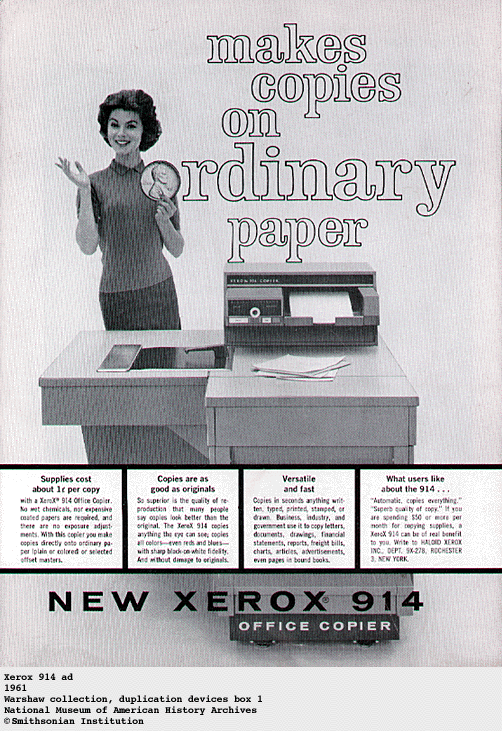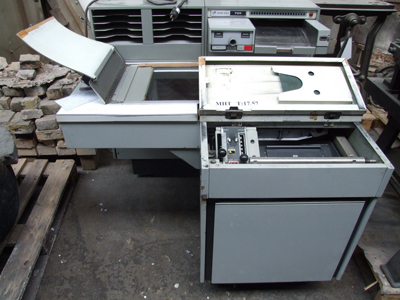

Early Xerox Copiers by Dave Eason
XEROX 914 - 1959. The Xerox 914 was the first automatic office copier to make copies on plain paper. It was introduced by Haloid Xerox. A floor-mounted device, it was designed by James G. Balmer of Armstrong-Balmer & Associates, in collaboration with Don Shepardson, John Rutkus and Hal Bogdenoff of Xerox, who had developed an engineering prototype. Xerox named their first product the 914 because it could reproduce documents up to 9 inches by 14 inches in size. It took about 15 seconds for the first copy to come out, and 7 seconds for each additional copy. It was 42 in. high, 46 inches long, 45 inches wide and weighed 648 pounds. The advertising campaign consisted of a TV commercial with a little girl making copies for her father who was dressed as a businessman. A single 914 had a price tag of $29.500 while competitors' wet copiers were sold for about $400, so Xerox copied IBM's leasing system whereby a company could lease the copier for $95 per month (2000 copies free) and 5c per extra copy. Xerox made four versions of the machine: 914, 420, 720 and 1000. The only difference being the motor speed. The 914 could make 7 copies a minute while the 1000 could make 17 copies a minute. The Xerox 914 sold as many units in the first 6 months as what had been projected to be the entire lifetime demand for the product - and the number was that low only because they couldn't physically make enough 914's to meet the demand!
In 1972, I was a messenger boy for a London solicitors and they had a 720 that I remember very well even though I was only 15 at the time. It was my first job and I was sent to Xerox in Euston London for a one day Key Operators course. A key operator was the person that could clear jams, load paper etc. No one else was allowed to touch the machine. We were even given a certificate by Xerox to display on the office wall. We had a requisition system so if any staff need copies I would do the copies, providing they had the requisition slip attached to it. The machine was very slow and you had to select the number of copies via a click dial. As the scanner bounced back to aim for the start again it had a very pronounced clonk. If the machine jammed we were told to open the doors slowly as the jammed paper would or could ignite. It did this on a few occasions and filled the office with smoke. This was an old building, so no sprinkler system on site. The doors were shut again quickly to let it cool down. If memory serves, I believe Xerox placed a fire extinguisher inside the door.
The drum was huge and made of selenium. Any exposure to light, fingers prints or breath would render it useless and they were very expensive. The engineer had to put it in a black sealed bag on service visits. After a few months, the company rented a Xerox 6400. It had a curved glass for scanning and 5 reduction enlargement modes. The clucking an clunking of the lens barrel setting up stays with me to this day. Very noisy, unlike modern stepper motors. I later went on to become a copier engineer with Toshiba for 20 years.The Xerox 720 service engineer would rub minor scratches out of the drum by using Brasso, a metal polish. They found out years later, even when I was repairing them, that Brasso would release arsenic to the air space as you polished the drum (Drums were selenium Arsenic). Now all drums are organic and safe, so they say. Copiers became very clean as they progressed. In the early days it was a messy job and toner dust was all over the place. Blow your nose at the end of the day and you can image the rest. Glad I got out as not sure what I would have been exposed to over the years As an ex-print/copier engineer, I once remember seeing a really old Xerox in South London. I believe it was some sort of research facility. I am talking about the 1980's. The machine had a pan attachment and I believe that once you exposed the pre-sensitised paper, it was placed in this heater that looked like a grill on a cooker. It was also the size of a fridge freezer.
I actually worked for AM Multigraphics, a huge American company you may know as Addressograph. They became AM International and went bust in 1996 after130 years. Chapter 11 in the early 80's, and I am afraid copiers were their downfall (Xerox). They made small offset litho machines and 75 of the top UK companies had a print room facility, even the American Embassy in Grosvenor Square where I recall "Chew Backa" an operative who chewed tobacco all day. AM International, I hear, turned Xerox away when approached in the early days, saying it will never take off. Rank took it on and the rest is history. I also heard AMI refused plastic credit cards. They were asked about these because of the Addressograph tags they made for the Army and addressing. "No thanks, we don't want those, it will never take off." Famous last words eh?


1961 Xerox 914 Advertisement and photo of Xerox 720 copier. Photos couretesy of Dave Eason